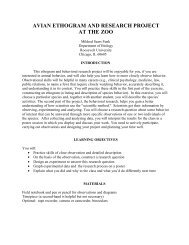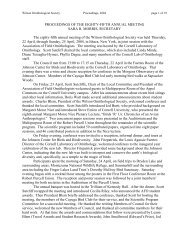Available now - Wilson Ornithological Society
Available now - Wilson Ornithological Society
Available now - Wilson Ornithological Society
You also want an ePaper? Increase the reach of your titles
YUMPU automatically turns print PDFs into web optimized ePapers that Google loves.
WOS 2010 ~ ABSTRACTS p. 22<br />
Japanese honeysuckle (Lonicera japonica) is an invasive plant found throughout the United States that bears fruits<br />
that are present during periods of avian migration. The fruits provide a source of protein and nutrients for<br />
frugivorous birds, especially migrant birds that switch to frugivory during migratory period. This implies that birds<br />
that consume the fruits ultimately disperse the seeds of the fruits, contributing to the dispersal of the invasive plant.<br />
A study of the relationship between the seed-dispersing birds and the honeysuckle can have important implications<br />
when considering the management of this invasive plant; more specifically, identifying dispersers as migrant or<br />
resident birds could provide a timeline for more effective management and control of the honeysuckle plant. This<br />
study compared honeysuckle consumption of resident birds against migrant birds in Granville, Ohio during mid-<br />
September to late October 2009 to provide insight into management options. Migrant birds of the area showed a<br />
higher amount of honeysuckle consumption, implying a larger role in dispersal of seeds over resident birds.<br />
Additionally, the honeysuckle was consumed by seven species previously identified as frugivores by other studies<br />
and the majority of consumption occurred within a specific two-week period during the course of the study,<br />
indicating a window of time in which honeysuckle could effectively be managed. The fall migratory patterns of<br />
these species within the study site can be monitored to, in combination with cutting the plant in a timely manner,<br />
effectively decrease the dispersal of the invasive plant.<br />
29 S Quantifying incubation behavior of Common Eiders nesting on Jordan’s Delight Island, Maine. Monika<br />
Parsons and Frederick A. Servello, Dept. Wildlife Ecology, Univ. Maine, Orono, ME 04469, and Cynthia S. Loftin,<br />
US Geological Survey Maine Cooperative Fish and Wildlife Research Unit<br />
Eiders rely on both concealment and high incubation constancy to prevent egg loss to predation. Female eiders will<br />
break from incubation to drink from the nearest water source, but the timing, frequency and duration of incubation<br />
recesses vary considerably across the eider breeding range. Studies of causes of variation have been limited, and the<br />
importance of weather and predator activity has not been addressed directly. Our objectives were to quantify the<br />
characteristics of incubation recesses on a breeding site in Maine and to determine the influence of environmental<br />
factors and disturbance on recesses. We conducted our study on Jordan’s Delight Island, Washington County,<br />
Maine, in summer 2008-2009. We deployed Hobo temperature loggers with external probes (n =110) to remotely<br />
monitor nest temperature and infer incubation activity. Nests were visited initially to deploy loggers, and loggers<br />
retrieved at the conclusion of the nesting period to limit investigator disturbance. We instrumented 47 nests in 2008<br />
and 63 nests in 2009. We reliably detected 76 recesses exceeding 15 minutes in 2008 and 277 recesses > 15 minutes<br />
in 2009. The mean (± SE) length of incubation recesses in 2008 was 67.1 ± 5.0 min and 35.5 ± 1.1 min in 2009.<br />
Most birds on Jordan’s Delight recessed during daylight hours ( 2=19.57, p





